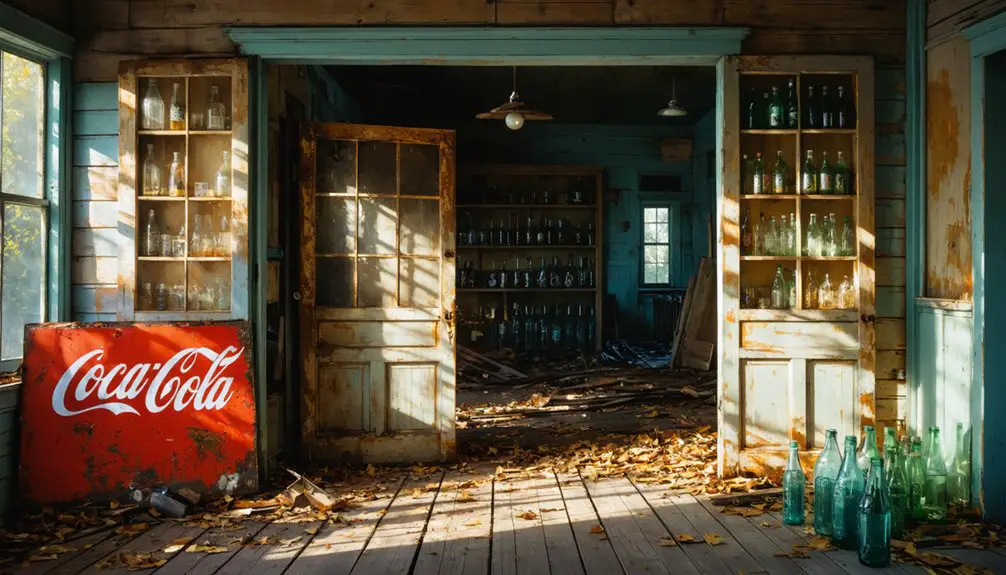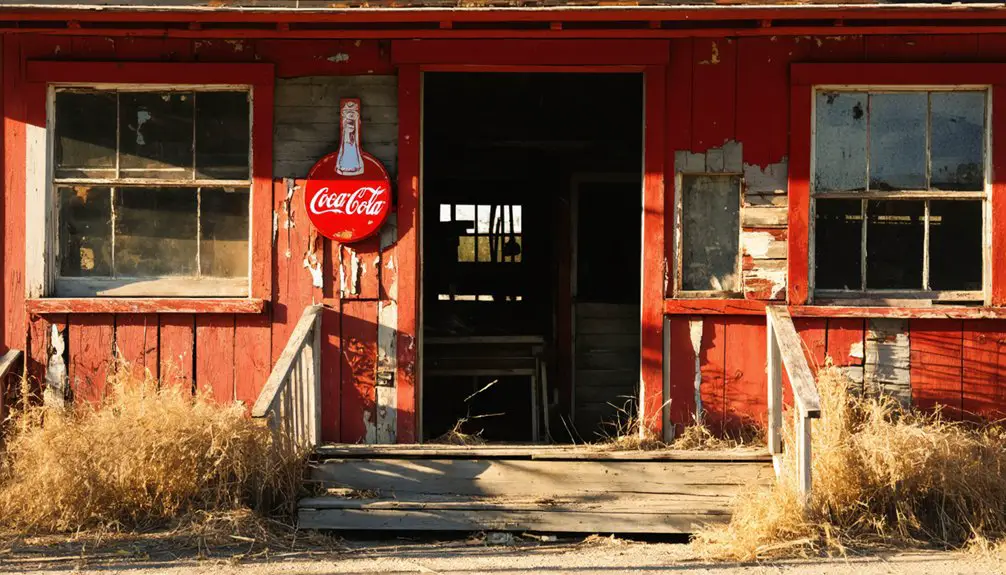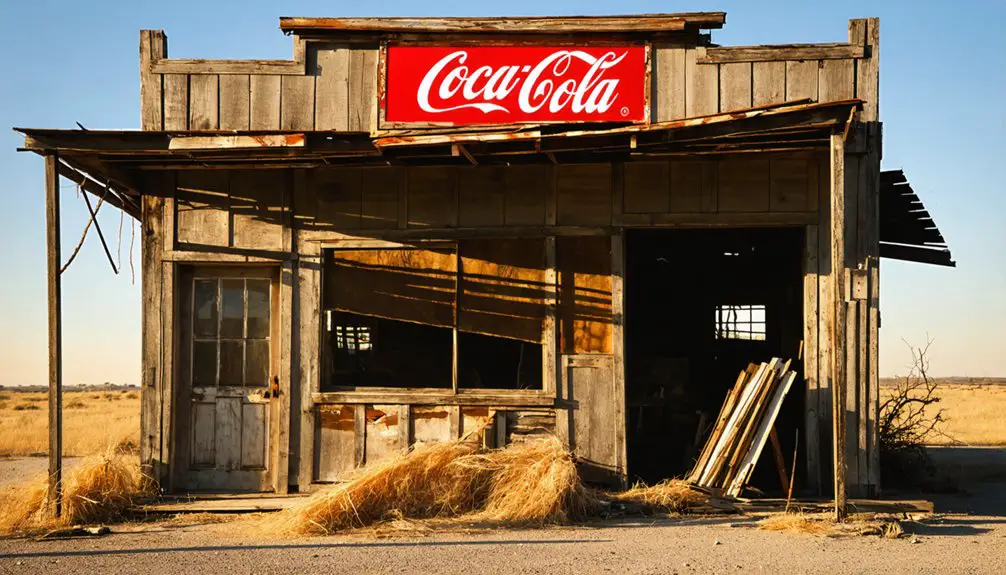You’ll discover Coke’s fascinating transformation from a bustling frontier town of 200 residents and 12 businesses in 1892 to a ghost town within just four years. Located in Coke County, Texas, the settlement struggled with drought, isolation, and economic challenges near historic Fort Chadbourne. While cotton farming briefly revived the community after its 1907 relocation, water shortages and agricultural setbacks sealed its fate. The town’s dramatic rise and fall holds deeper stories in Texas frontier history.
Key Takeaways
- Coke was established in 1892 with 200 residents and 12 businesses but declined to just 25 people within four years.
- The town relocated in 1907 near Yellow Wolf Creek, focusing on cotton farming as its primary economic activity.
- Chronic water shortages, boll weevil infestations, and dropping cotton prices contributed to the town’s ultimate abandonment.
- The community faced severe isolation, requiring up to 25 days for supplies and news via stagecoach during its frontier period.
- Fort Chadbourne’s abandonment in 1867 impacted the area’s stability, though ranching continued under the Odom family’s management.
Early Settlement and Town Origins

While the area initially fell under Bexar County’s jurisdiction with San Antonio as its seat, Coke County emerged as its own entity on April 23, 1889, named after Texas governor Richard Coke.
Carved from Bexar County’s vast territory in 1889, Coke County took its name from Texas Governor Richard Coke.
You’ll find the roots of settlement trace back to the 1870s and 1880s when ranchers first claimed the open range, competing with buffalo herds for grazing land. Fort Chadbourne‘s military presence in the northeast had already established some stability in the region since 1852. A massive buffalo hunt in 1887 drastically reduced the native herds in the area.
Early commerce centered around ranch life until settlers like J.Q. McCabe helped build the first stores. By 1890, the area boasted 163 farms and ranches across the county.
Settler conflicts emerged dramatically in Hayrick, the county’s first seat, where political tensions led to two burned courthouses. The town’s ultimate decline came after losing a heated county seat election to Robert Lee by just 48 votes.
Life in the Frontier Days
As settlers established themselves in frontier Coke County, they faced formidable challenges that shaped daily life throughout the 1870s and 1880s.
You’d find ranchers battling drought conditions while struggling to maintain their cattle drives across open ranges. The constant threat of Native American raids meant you couldn’t let your guard down, though the Texas Rangers’ Frontier Battalion worked tirelessly to protect the community. Under Major John B. Jones, the battalion successfully reduced raids to just four incidents in their second six months of operation. The Rangers’ effectiveness was evident as they engaged fourteen Indian parties in their first six months of service.
Life on the frontier meant dealing with isolation – you’d wait up to 25 days for supplies or news to arrive via stagecoach.
The introduction of barbed wire brought its own troubles, as fence cutters threatened ranchers’ property.
Through it all, Fort Chadbourne served as an essential hub for military protection and communication, helping settlers maintain their foothold in this rugged territory.
The Rise and Decline
Once Coke established its post office in 1892, you’d find a bustling frontier town of 200 residents with 12 thriving businesses.
But this prosperity wouldn’t last – within just four years, you’d see the population plummet to only 25 people, highlighting the volatile nature of frontier community dynamics.
The town’s fate took another turn when it relocated in 1907, pinning its hopes on cotton farming.
The land near Yellow Wolf Creek offered promising agricultural opportunities for the new settlement.
But you couldn’t escape the perfect storm of challenges that followed: devastating boll weevil infestations in the 1920s, persistent droughts, and crashing cotton prices.
These agricultural shifts, combined with chronic water shortages, steadily eroded the town’s foundation, much like how the transition to oil-burning locomotives would later devastate other Texas towns.
Legacy of Fort Chadbourne
You’ll find Fort Chadbourne’s legacy deeply woven into Coke’s early development, as the 1852 military outpost served to protect settlers and Butterfield Overland Mail routes from Native American conflicts.
The fort’s strategic position attracted initial settlement to the area, with up to 450 soldiers stationed there during its peak military years. Today, six limestone buildings have been carefully restored to preserve this historic site.
When the military abandoned the post in 1867, the site shifted to ranching under the Odom family, cementing its role in the region’s civilian development while preserving an important piece of Texas frontier history. The Fence Cutting Wars of the 1880s marked another significant chapter in the fort’s history.
Military Settlement Origins
Before the town of Coke emerged, Fort Chadbourne stood as a critical military outpost on land owned by Texas Declaration of Independence signer Samuel Maverick. Instead of selling the property, Maverick’s military leasing arrangement with the U.S. Army enabled fort construction in 1852, establishing a strategic presence in hostile Comanche territory.
You’ll find the fort’s rich military heritage reflected in these defining features:
- Served as an essential stop along the Butterfield Overland Mail route
- Protected settlers and mail carriers for 15 years until 1867
- Housed the 8th Infantry troops who defended against regional conflicts
- Preserved through private ownership, first by Maverick and later by the Odom family
The fort’s establishment marked the beginning of permanent settlement in the region, laying groundwork for future community development. Through decades of service, 27 soldiers lost their lives while stationed at this historic outpost. Today, the Fort Chadbourne Foundation continues to preserve this significant piece of Texas history through careful restoration efforts.
Frontier Protection Role
The frontier protection legacy of Fort Chadbourne expanded far beyond its military foundations, serving as an important defensive stronghold against Native American raids in West Texas.
As a military outpost housing up to 450 soldiers, you’ll find that its strategic location played a significant role in frontier defense and settler safety.
You can trace the fort’s protective influence through its guardianship of the essential Butterfield Overland Mail route, where troops guaranteed safe passage for mail carriers, passengers, and goods across dangerous territory.
The Fourth U.S. Cavalry and other units maintained order here, engaging in conflicts to protect settlers and communication lines.
Even after Confederate forces took control during the Civil War, the fort continued its defensive mission, remaining a symbol of safety in an untamed land.
Strategic Community Development
While Fort Chadbourne‘s military presence diminished by the late 1860s, its strategic importance lived on through private ownership and community development.
You’ll find that Samuel Maverick’s initial land acquisition and subsequent private ownership through families like the Odoms shaped the fort’s legacy of resource management and community engagement.
- The site evolved from a military post into an essential ranching community hub
- Private ownership under the Odom, Wylie, and Richards families preserved the fort’s heritage
- The location served as a significant stop on the Butterfield Overland Mail route
- The fort’s presence influenced regional settlement patterns and transportation infrastructure
The fort’s shift sparked economic growth through ranching and agriculture, while maintaining its role as a cornerstone of local heritage.
Local Economy and Resources
You’ll find Coke’s early economy centered on ranching and farming, with nearly 14,000 cattle counted by 1890 alongside 163 agricultural operations.
While ranchers and farmers struggled with unreliable water sources in the arid region, they persisted in developing the land for agriculture.
The discovery of cotton’s viability and later oil deposits brought brief periods of prosperity, though neither proved sustainable enough to prevent the town’s eventual decline.
Early Ranching and Farming
During Coke County’s formative years, ranching emerged as the dominant economic force, with 163 farms and ranches supporting over 13,800 cattle by 1890. The county’s ranching practices followed a “gentlemen’s agreement” system, where cattlemen respected each other’s grazing territories based on first-come, first-served principles.
You’ll find the early landscape was shaped by these pioneering ranchers and farmers:
- Cattle barons established massive herds, with numbers reaching 46,000 by 1900.
- Farming techniques evolved as settlers improved roughly 4,000 acres for agriculture.
- Cotton and corn production spread across 11,200 acres, diversifying the local economy.
- Open range gradually transformed into organized ranch operations spanning 605,842 acres.
This blend of ranching and farming created a resilient economic foundation that defined Coke County’s early development.
Water Source Challenges
The semiarid climate of west-central Texas posed significant water challenges for Coke County’s growing agricultural community.
You’ll find that water scarcity has always been a defining feature of the region, with groundwater availability limited by the area’s complex geology of shale, sandstone, and gypsum formations.
In 1968, the county’s total groundwater use reached only 1,900 acre-feet annually, split between industry, irrigation, and domestic needs.
While the E.V. Spence Reservoir, completed in 1969, brought some relief with its 488,750 acre-feet capacity, groundwater management remained essential.
You’d notice how the area’s farmers and ranchers had to carefully balance their water usage, especially during drought periods.
The combination of limited freshwater access and moderately saline groundwater continues to shape the region’s development potential.
Cotton and Oil Impact
Cotton’s reign as Texas’s economic cornerstone transformed Coke’s landscape from the 1820s through the early 1900s.
You’ll find a cotton legacy woven into every aspect of local life, from the sharecropping families who worked the fields to the railroad depots that shipped bales to distant markets.
- Cotton warehouses and exchanges sprang up, attempting to organize the bustling market
- Local families’ fortunes rose and fell with cotton prices, determining their social standing
- Railroads connected Coke’s cotton producers to national and international buyers
- Labor dynamics shifted from enslaved workers to sharecroppers and migrant laborers
The oil shift brought dramatic change to Coke’s economic landscape.
As drilling operations emerged alongside cotton fields, residents found new opportunities beyond agriculture, forever altering the community’s financial foundation and social structure.
Notable Historical Events
Marked by tragedy and political tensions, Hayrick’s brief tenure as county seat exemplified the turbulent early history of Coke County.
You’ll find the ghost town’s story punctuated by two suspicious courthouse fires, likely sparked by fierce political rivalries that divided the region. The contentious 1891 election sealed Hayrick’s fate when Robert Lee won by a mere 48 votes, triggering an exodus of residents.
Earlier, Fort Chadbourne’s establishment in 1852 brought soldiers and stage line workers to the area, though the Civil War forced its abandonment by 1861.
The 1920s dealt another blow when boll weevils and drought devastated cotton farms, pushing many families away. By the 1930s, even law enforcement struggled with illegal activities in the county’s remote western sections.
Preservation and Remembrance

Despite the decline of these once-thriving communities, dedicated preservation efforts guarantee their stories live on.
You’ll find local historical groups working tirelessly to document and maintain these remnants of Texas heritage, with organizations like the Mineral Wells Heritage Association leading the charge in cultural heritage preservation.
- Hayrick Cemetery stands as a monument to the former county seat, with maintained markers and grounds
- Fort Chadbourne’s ruins attract history enthusiasts to explore frontier military life
- Silver’s abandoned structures tell tales through their bullet-riddled walls
- Sanco’s relocated buildings preserve the physical connection to early settler life
Through community engagement, these ghost towns continue to educate and inspire.
Local historians contribute to digital archives, while historical societies host events celebrating these forgotten places, ensuring their legacy endures for future generations.
Frequently Asked Questions
What Happened to the Original Settlers’ Descendants After Leaving Hayrick?
You’ll find most descendant stories show families migrating to Robert Lee, while others scattered across Texas. Their migration patterns reveal they sought better opportunities where water and commerce flourished.
Are There Any Remaining Structures or Ruins Visible Today?
Like scattered bones of a forgotten era, you’ll find few remaining structures except a headless robot sculpture made from oil field weights, marking where industry once thrived in this desolate landscape.
What Native American Tribes Originally Inhabited the Coke County Area?
You’ll find rich cultural heritage from the Comanche, Tonkawa, Lipan Apache, Kickapoo, and Kiowa tribes in this area’s tribal history, with the Jumanos living here before being displaced.
How Did Residents Get Their Water Supply Before Moving?
You’ll find early settlers relied on Wildcat Springs, adapting creek banks with basic plumbing. They’d collect water manually from natural water sources and dig wells to meet their daily family needs.
Were There Any Significant Archaeological Findings in the Ghost Town?
You won’t find major archaeological discoveries there, though surface historical artifacts like building remains exist. The area’s most significant findings actually come from prehistoric sites nearby rather than the ghost town itself.
References
- http://siouxsue.blogspot.com/2010/12/another-texas-ghost-town-hayrick-texas.html
- https://www.txgenwebcounties.com/coke/cokehistory.html
- https://en.wikipedia.org/wiki/Coke_County
- https://www.texasescapes.com/EastTexasTowns/Coke-Texas.htm
- https://en.wikipedia.org/wiki/List_of_ghost_towns_in_Texas
- https://kids.kiddle.co/Edith
- https://www.reporternews.com/story/news/columnists/big-country-journal/2018/10/28/big-country-journal-coke-county-ghost-town-sanco-has-its-own-robot/1797419002/
- https://www.tshaonline.org/handbook/entries/sanco-tx
- https://www.texasescapes.com/TexasTowns/Sanco-Texas.htm
- http://files.usgwarchives.net/tx/coke/newspapers/history/oralhist.txt



